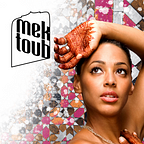Dot Line Dot
Some find Moroccan henna obscure and difficult to understand, let alone replicate. It sure looks that way when you first see a Moroccan henna design, with all those straight lines and geometry. But what if it was simpler than you imagined? What if it was as simple as dot line dot? That’s it! Look at Moroccan henna designs, especially Fessi and you will see what I am talking about. Right?! The design below is a great example done by our Mektoub instructor Zakia, who is a master of the Fessi style of Moroccan henna, and shows a new dimension of this dot-line-dot concept.
Before the 2022 Mektoub henna workshop, we already had a conception of Moroccan henna using dots and lines in various combinations. This was part of our classes on Moroccan henna and helped students break down designs into their components and create their own. What we learned from Zakia cracked this idea wide open and helped us see it on another level. But first some history of henna in Morocco.
As we can’t have clear, hard evidence of henna use in Morocco before the written word or photography, we can guess that it was probably applied with fingers and/or pointy sticks. We have also read, heard stories of, and seen photos of resist designs done in various ways. We heard of Moroccans who would create a dough-like ball of henna paste and put that ball in their hand, wrapping the hand closed around the ball, and then wraps their hand up with fabric. They’d sleep with their hands wrapped up like this, and, upon unveiling it in the morning there would appear the stain of the henna, cut through with lines where the henna didn’t stain the creases in the palm, forming a kind of design. We also heard and saw photos of resist designs that were created by wrapping string or strips of fabric around the base of the fingers, across and around the hand. Henna was smeared on the hand, and anything that wasn’t covered with string or fabric would be stained by the henna. I theorize this is where that common Moroccan henna layout came from: the line separating thge fingers from the palm, and then the palm filled with diagonal shapes, but I digress.
Here’s another story I heard from my mother-in-law. In bygone days, henna artists would make their henna paste by chewing the leaves. When the wad of leaves was gooey and wet, they would pull a wad of paste from their mouths. Pinched between their fingers, they would hover over over the skin, then spread their fingers and the wad would stretch in a string. And when they laid it down on the hand, it would make a dot where their fingers were, and a line where the spitty string was, creating the traditional dot-line-dot we all know and love. I am sure if you are picturing that in your head, you can imagine that this would look like a dot-line-dot, right? We tested this out with henna paste we mixed in the bowl (we couldn’t find fresh henna leaves in NYC to chew into a paste) and it worked. It was many years ago at a Moroccan henna class we were teaching in NYC. Monique was enchanted with this idea and started to experiment with the method, and we all stood and watched in awe. Those henna-chewing, Moroccan henna artists invented a style of design that persists to this day!
Let’s continue looking at the evolution of this dot-line-dot concept, because it does indeed evolve, and looking back it seems it couldn’t have happened any other way. In addition to the resist methods, Moroccan henna artists also used sticks to apply henna; these sticks were called “mrwed” and there are still artists today who apply henna this way. Their method was similar to the saliva-based paste where the paste was elastic, and instead of using the fingers they dipped the stick in the paste, touched the tip to the skin (leaving a dot), lifted up and dragged to lay down that elastic line of henna (the line), and then touched down again to end the line with a….dot! In case you weren’t keeping track, that’s dot-line-dot.
But wait, the evolution continues! Around the 1970s Morocco started to import medical supplies from the west, among them the syringe. I want to meet that henna artist who had the idea to cut the tip off a syringe, suck up some henna paste in her syringe and start to draw with it. There should be a statue erected in her honor. It’s right up there with the first person to roll a cone from a discarded milk bag, as goes the legend of the henna cone developing in India. In Morocco, almost all the henna artists still use the syringe and create amazing designs with this tool. If you have ever tried to do henna with a syringe you will probably know that when you first press the plunger the henna starts coming out very quickly, maybe quicker than you can draw (this happens with cones too), and that excess henna forms a dot. Once you pick up speed with the syringe you can lay down a line, and then as you slow down the henna again pools up, forming a dot. Yes, another dot-line-dot.
Now look back at Moroccan henna designs and those dots and lines will really jump out. Sure there are also bold lines, and curvy lines, and zigzag lines, but still all lines. Even so it’s possible to go back to basics and make designs just from straight lines and dots. It’s all part of the magic of Moroccan henna and explains why there is nothing in any other henna culture quite like Moroccan henna. For more examples of this kind of work check out the instagram feeds of our Mektoub instructors.
Zakia: @henna.zakia
Khadijah: @galerie_henna
Fatima: @tamolayt.henna
Souad: @souad_na9acha
Nadia: @marrakechhennaartcafe
